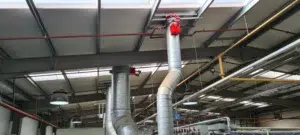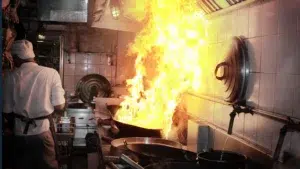
The Importance of Integrating Extraction Systems and Machinery into Fire Alarm Systems
When we talk about keeping workplaces safe, installing a fire alarm system is usually one of the first steps that come to mind. But a fire alarm system can do
Book your FREE, no-strings-attached Fire Safety Audit to ensure that you’re properly protected from the risk and comply with current fire safety legislation.
Get essential insights and updates
in fire safety – straight to your inbox!
What Is Carbon Monoxide and Why Is It Dangerous?
Carbon monoxide is produced by the incomplete combustion of carbon-based fuels—common in many industrial operations involving furnaces, generators, vehicles, welding, or combustion-powered tools.
The real danger lies in how CO replaces oxygen in the bloodstream, reducing the body’s ability to deliver oxygen to vital organs. Even low levels of exposure over time can cause serious health issues, while high levels can be fatal in minutes.

Why CO Is a Hidden Threat in Industry
Industrial environments are particularly vulnerable due to:
Symptoms to Watch For on the Job
CO poisoning often mimics common ailments, leading to delayed responses. Symptoms may include:
Workers may mistake these symptoms for dehydration, overexertion, or even stress—delaying critical intervention.
Prevention: A Workplace Imperative
Mitigating carbon monoxide risk in industrial settings isn’t just about compliance—it’s about culture. Here’s what responsible leaders and EHS professionals should ensure:
Final Thought: Culture Drives Compliance
While regulations mandate CO safety protocols, true protection comes from fostering a safety-first culture. Leaders who prioritize preventive maintenance, ongoing training, and open safety communication build workplaces where hazards like CO are actively managed—not ignored.
Carbon monoxide doesn’t announce itself. But with the right systems in place, your team will always be prepared.
Let’s lead by example. Workplace safety isn’t a checkbox—it’s a commitment.

When we talk about keeping workplaces safe, installing a fire alarm system is usually one of the first steps that come to mind. But a fire alarm system can do

Fire safety is crucial for every business, institution, and community. One key role that helps maintain fire safety standards is the fire marshal. Proper training equips fire marshals with the

When we think about fire safety, things like fire extinguishers, smoke alarms, and sprinkler systems usually come to mind. But there’s one tool that’s often forgotten—the fire blanket. It’s simple,
Video Smoke Detection is perfect for a fast response to fires in high roofed buildings and harsh operating conditions.
Watch Smokecatcher detect smoke in an MSW storage building. The smoke is coming through from a fire in the adjoining storage area.
Watch Smokecatcher detect a fire in an SRF Storage bunker. Sadly, the alarm wasn’t responded to and the site lost a 4hr window of opportunity between smoke detection and flames appearing.
Video Smoke Detection overcomes the risks of stratification and other challenges for early fire detection in logistics and storage facilities.
Watch Fire Rover detect and suppress a fire in the waste bunker at an EFW facility!
See how the Fire Rover detects and suppresses this fire at a clients tipping hall. Note how the smok is spreading out at low leve, rather than rising. This is called ‘stratification’ and is one of the many reasons why roof-mounted smoke detection systems like beam detectors and HSSD is not suitable for many recycling applications.
Watch the Fire Rover detect and suppress a fire at a battery storage facility. This targeted and intellegent control makes the Fire Rover particularly well suited to high hazard storage applications.
Watch the Fire Rover tackle a battery fire in a tipping hall. Note how the exploding battery cells start three separate fires, which the operator individually suppresses (whilst avoiding the site operators in the vicinity).
Get essential insights and updates in fire safety – straight to your inbox!